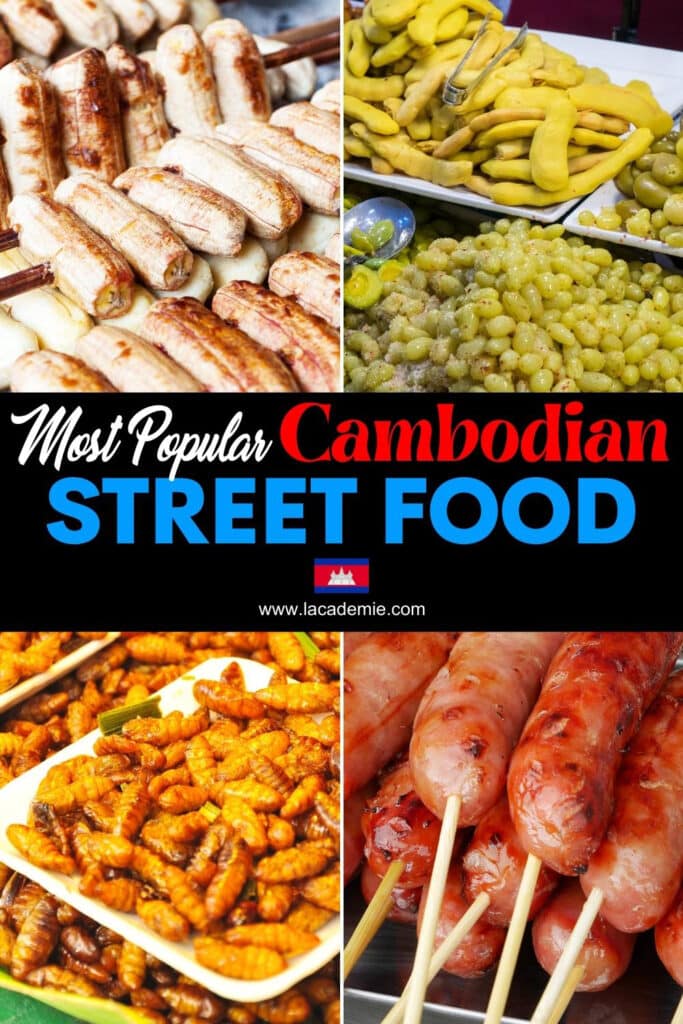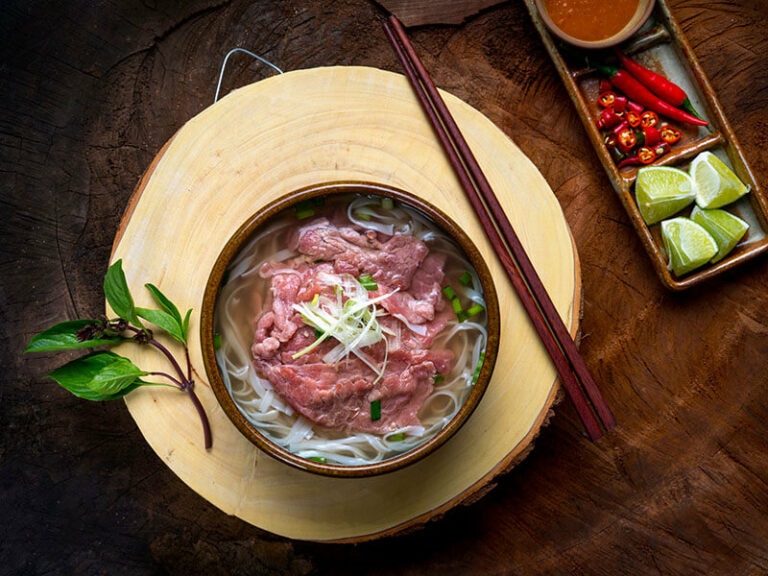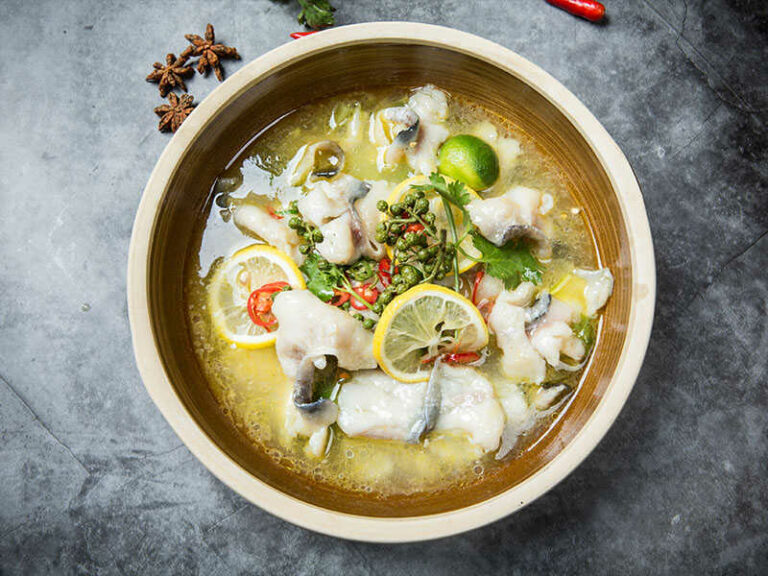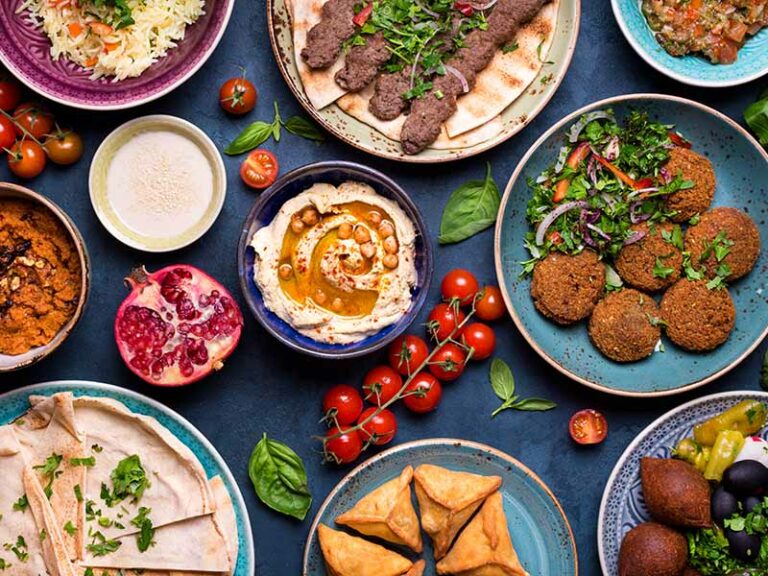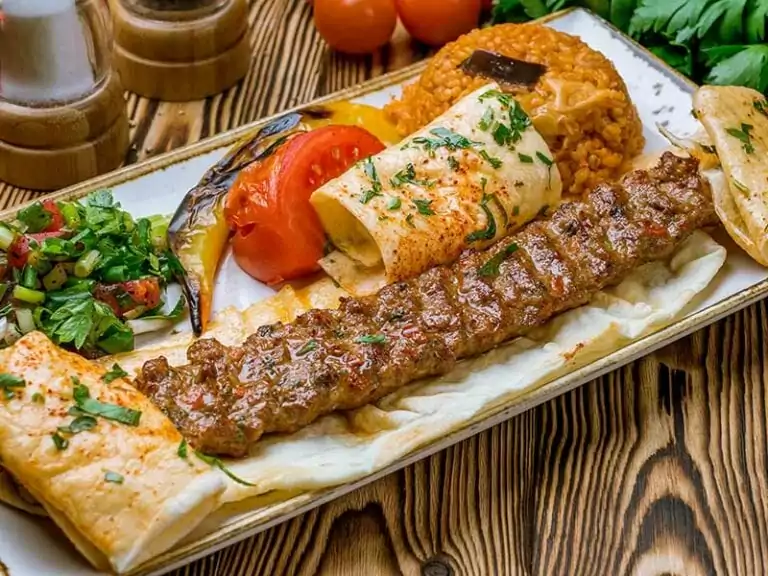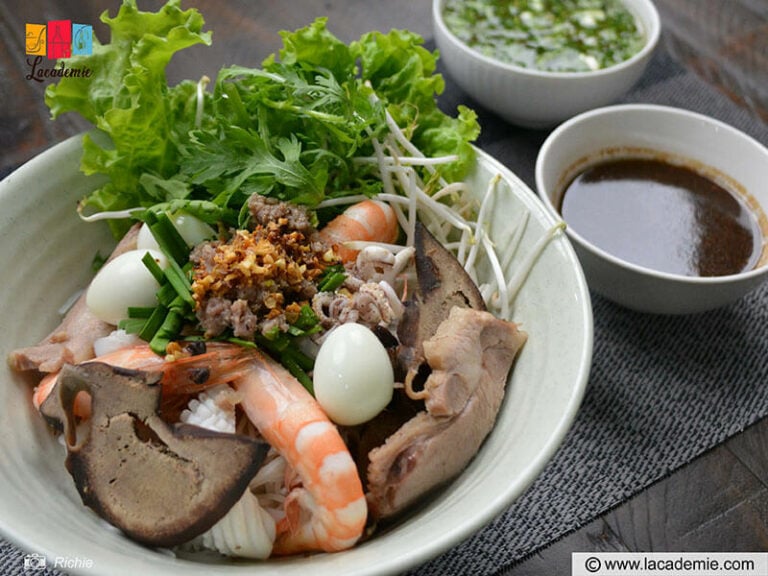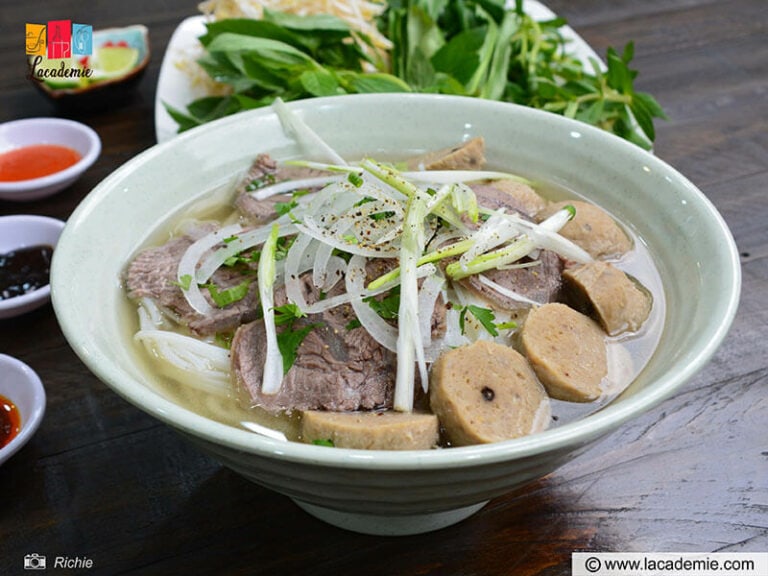When visiting Cambodia, you should never miss Cambodian street food because these delicacies encompass various beauties from the whole country’s culinary culture.
If you have never experienced such marvelous delicacies from Cambodia, it is time to explore more about them. In case you don’t know where to start, my humble article right here will give you the best recommendations. Check it out now!
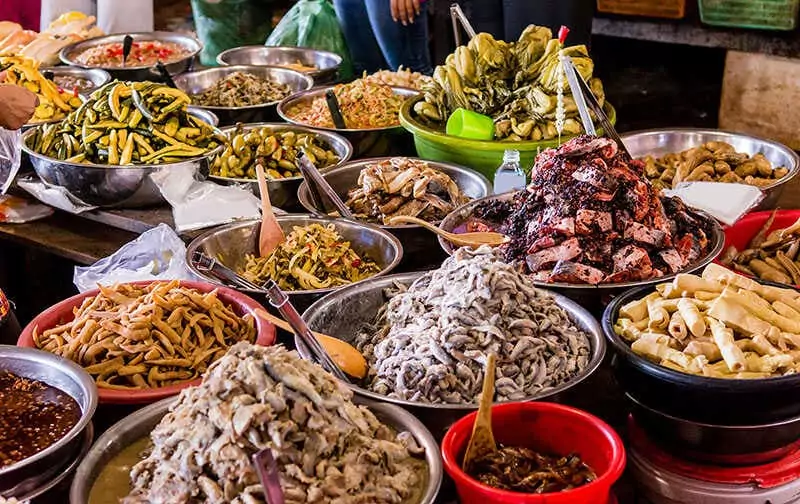
1. Kralan
(Bamboo Sticky Rice)
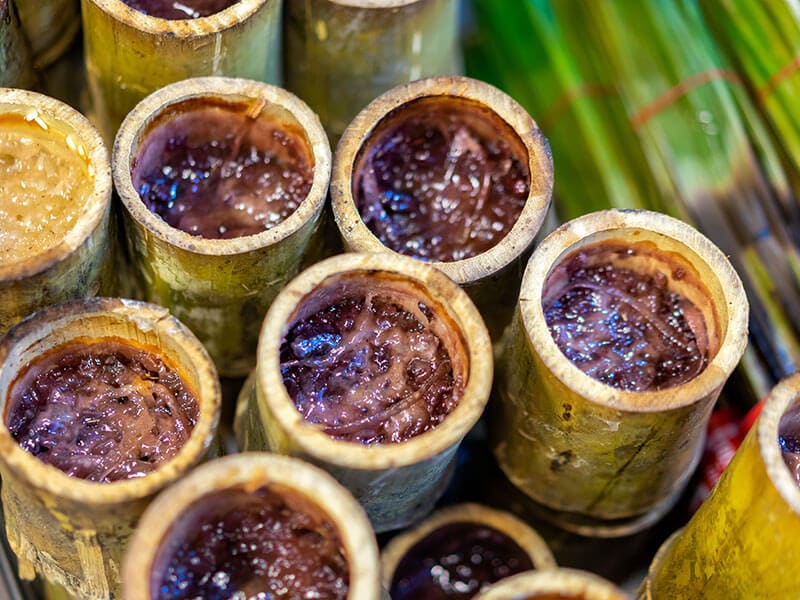
When walking on the streets of Cambodia in the early morning, you can smell the sweet aroma of rice emanating from the stalls selling Kralan.
Kralan is a popular dish in Cambodia made from glutinous rice and black-eyed peas or beans soaked in coconut milk before being stuffed in bamboo tubes.
Traditionally, Kralan is slowly cooked over embers or firewood. The delicious Kralan will have evenly cooked and fragrant rice, without the bamboo bark being burned.
When you eat this dish, you will feel the sweetness of glutinous rice, the firm texture of red beans, and the richness of coconut milk. If you are curious about its taste, you can find this attractive dish at street vendors or shops in the market or on the street.
2. Bai Sach Chrouk or Bhai Sach Chrouk
(Rice And Pork)
Bai Sach Chrouk, a traditional breakfast dish among Phnom Penh locals, is a favorite of many tourists to Cambodia. Grilled meat is served with white rice and various side dishes, depending on the store.
Grilled pork, pickled vegetables, eggs, and onion oil are the must-have ingredients inside a portion of Bai Sach Chrouk. Although they seem simple, they work well with each other and create a pleasant feeling for the whole treat.
3. Bobor or Bor Bor
(Khmer Rice Porridge/Congee)
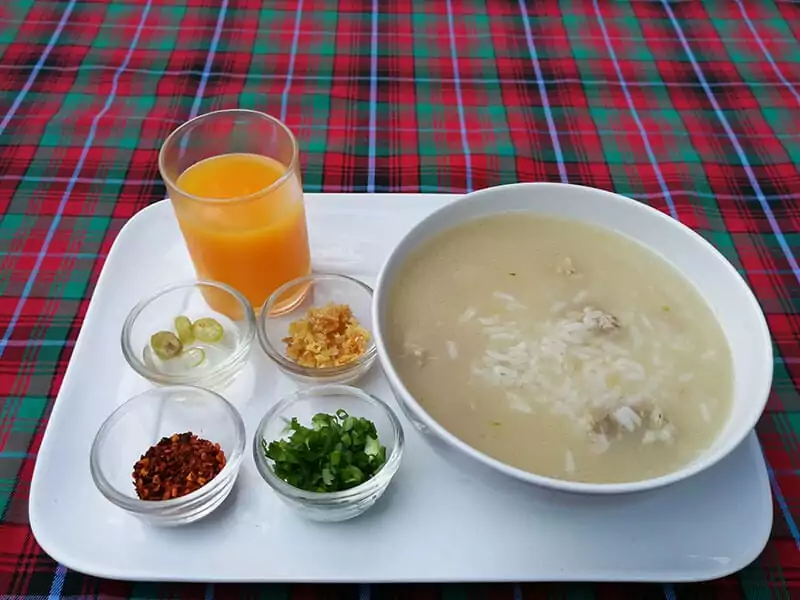
Besides the previous Bai Sach Chrouk, rice porridge is also a beloved breakfast treat in Cambodia. Imagine waking up, and it is a gray, cold morning; you might want nothing but a steaming hot bowl of rice porridge to fill up your empty stomach and warm up your soul.
Even though thousands of other Asian comfort foods are similar to Bobor, the Cambodian delight still has its own distinctiveness. Not only eating Bobor for breakfast, but many people in this country also love enjoying this food in other meals of the day.
It is reasonable since this delicacy is loaded with nutrients such as starch, proteins (from fish or chicken), and a lovely balanced taste. Bobor will also be healthier for a complete meal if you are not in the mood for something heavy such as rice or stews.
4. Lort Cha or Lod Cha
(Stir-Fry Rice Pin Noodles)
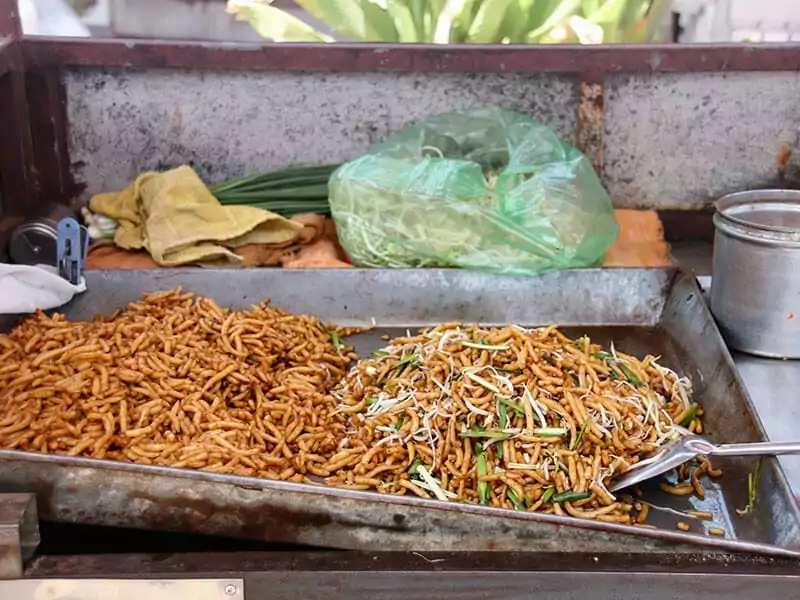
If you ask me about the most famous street food in Phnom Penh, I will no doubt suggest this tasty Lort Cha. Don’t confuse it with the famous Pad Thai; Lort Cha is a traditional Cambodian Stir-Fried Rice Pin Noodles.
There are other ways to call this Lort Cha, such as Lot Cha, Lod Cha, or Loht Cha. The term “Cha” is unchangeable since it means “stir-fry” in the Khmer language. The most distinguishing feature of this noodle dish is the kind of noodles used.
Cambodian people will utilize a special kind of short-strand rice noodles (rice pin noodles) for their delicacy. When cooked, the starch base will offer a lovely chewy texture that pairs beautifully with its main proteins (shrimp, pork) and vegetables.
Feel free to have Lort Cha for any meal of the day. Believe me, you’ll fall in love with this dish after the first try.
5. Nom Ka Chai or Num Kachay
(Chive Cakes)
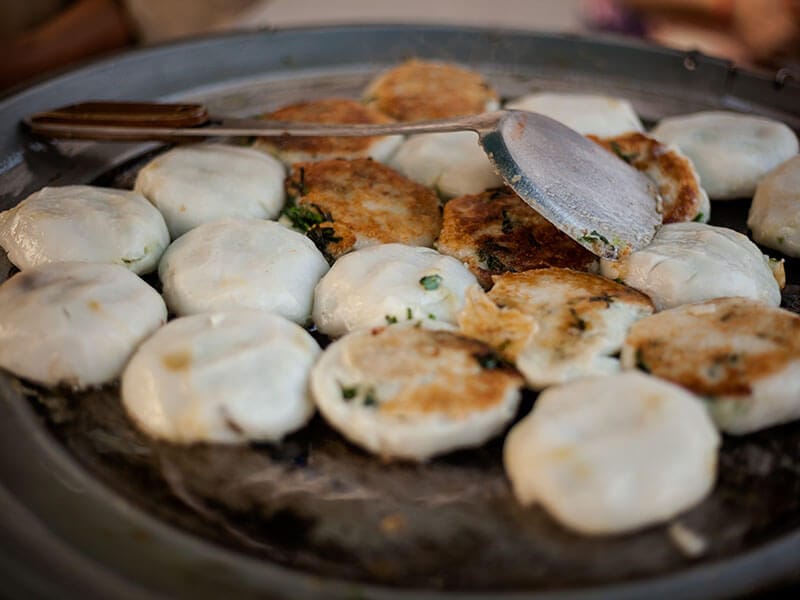
Small street vendors or mobile carts selling Num Kachay are common occurrences on the streets of Cambodia. Num Kachay is a fried cake made of glutinous rice flour served with a delicious sweet and spicy fish sauce.
Regardless of the fact that it is made from only fried sticky rice flour, this Chinese-inspired Num Kachay, with its crispy exterior and soft interior, is incredibly attractive.
Since this dish has its roots in a famous Chinese street food, you might see it familiar. Once having a bite, you can immediately taste the intense flavor of chives, which will be quite refreshing.
When combined with its special sauce, this Cambodian street delicacy provides a mouth-watering taste that I cannot describe in words.
6. Kuy Teav or Ka Tieu
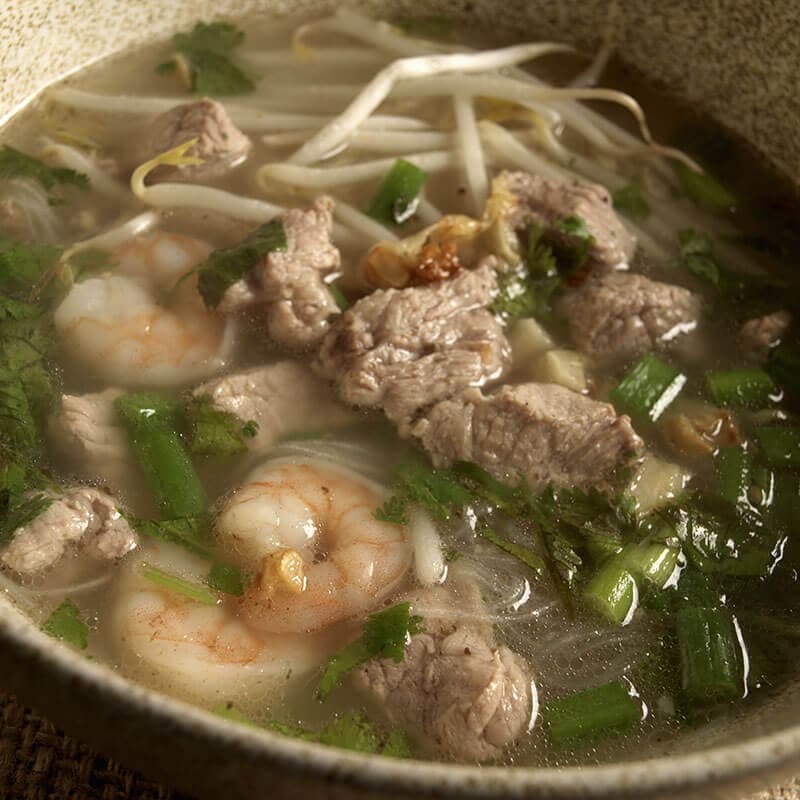
Besides Lort Cha, Kuy Teav or Ka Tieu is a prevalent Cambodian noodle soup listed as one of the most prominent Asian street foods. If you don’t want fried noodles, try this soupier option, and you won’t regret doing so.
If you walk along the streets, you will undoubtedly come across familiar images of Kuy Teav shops on the roadside. This dish, at first glance, is not too fancy. A standard bowl includes only a rich broth, chewy noodles, and thinly sliced meats that look incredibly appealing.
Pork, chicken, or even more exotic ingredients like pork tongue, intestines, or livers are utilized in a portion of Kuy Teav. Chopped fresh herbs are also added (or not, depending on your taste), resulting in a beautiful and unforgettable Cambodian Noodle Soup bowl.
7. Banh Chev or Banh Chao
(Crispy Pancakes)
Banh Chao was derived from a famous Vietnamese Crispy Crepe, Banh Xeo. Despite the relatively similar appearance, the Cambodian variation actually offers a more milky and richer taste since it contains more coconut milk.
For the fillings, you can choose between various options such as prawn/shrimp, chicken, bean sprouts, and onions. Its ingredients are quite different from the original version as people in Vietnam also add minced pork into their Banh Xeo.
All in all, no matter where this delicacy comes from, I can guarantee you the Cambodian Banh Chev is palatable, affordable, and accessible. Therefore, you should definitely eat it once when visiting Cambodia.
8. Num Pang Pate or Nom Pang
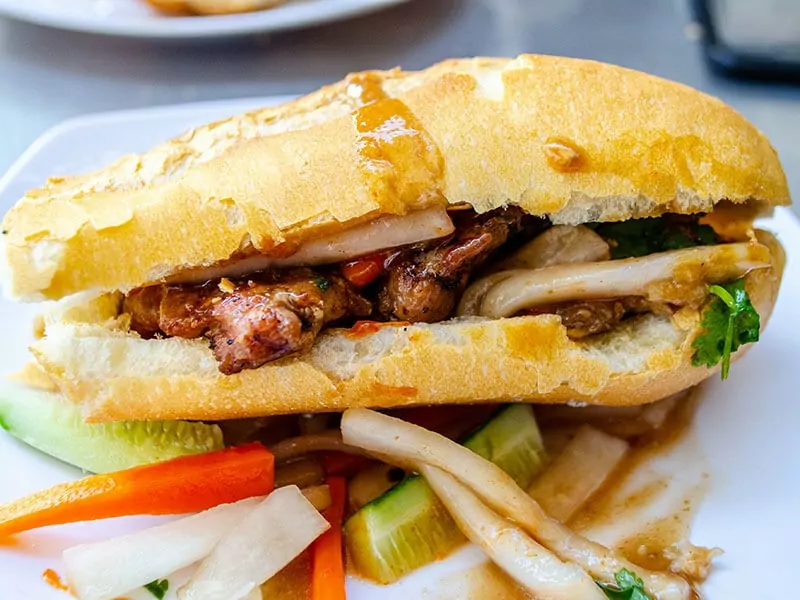
Although not as famous as its cousin Banh Mi in Vietnam, this Num Pang Pate or Cambodian Sandwich is also a street food that shows how French cuisine has a strong influence on the local cuisine.
Thanks to the creativity of Cambodians, they have modified recipes that are diverse and suitable for their people. Num Pang, nowadays, carries the significant identity of their country.
My advice for you is to try the basic filling of Num Pang on the first try. There will be red pork and paté, which are relatively easy to eat for many people.
9. Nom Bao
(Stuffed Steamed Buns)
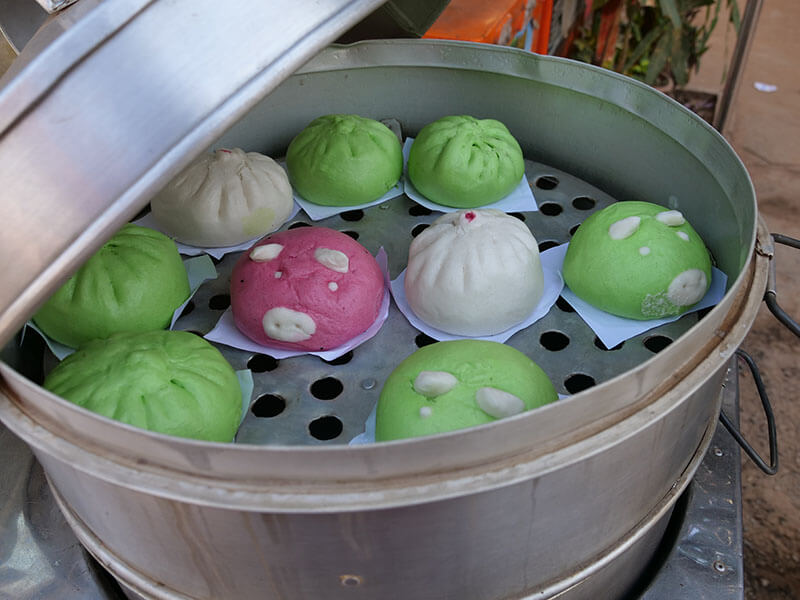
Cambodian cuisine is also solidly influenced by the signature Chinese delicacies, and Num Bao is proof.
The original version of Nom Bao is called Baozi in Chinese, and there is not much difference between the Chinese variant and the Cambodian one.
The most famous filling for Nom Bao is marinated minced pork (with fewer spices required compared to Baozi); yet, there are several other options for the protein used. A perfect Nom Bao needs to deliver a spongy exterior and juicy, well-flavored fillings.
It is pretty straightforward to find the stall that sells Nom Bao; you just need to notice if they have huge steaming racks with them or not. When eating, remember to remove the paper in the bottom of your Nom Bao; it is inedible.
10. Satay (Grilled Pork Skewers)
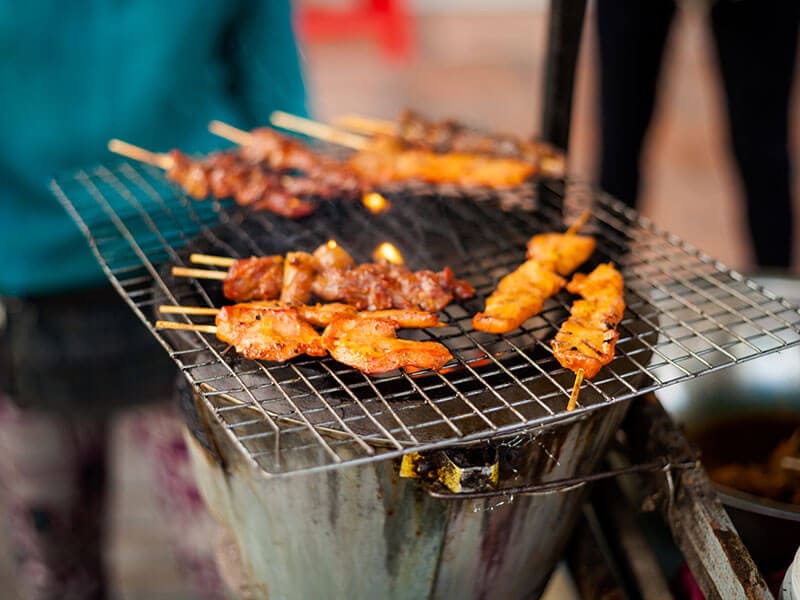
Although it didn’t originate from this country, Satay seems to be one of Cambodia’s most popular grilled foods. Especially in Phnom Penh, you can quickly encounter a pushing cart selling Pork Skewers while wandering on the street.
No one can resist such delicious Grilled Pork Meat, so you can try pairing it with almost every starchy base you are thinking about. Satay is sold at any time of the day in Cambodia, so there will be no reason not to give it a go.
11. Grilled Seafood
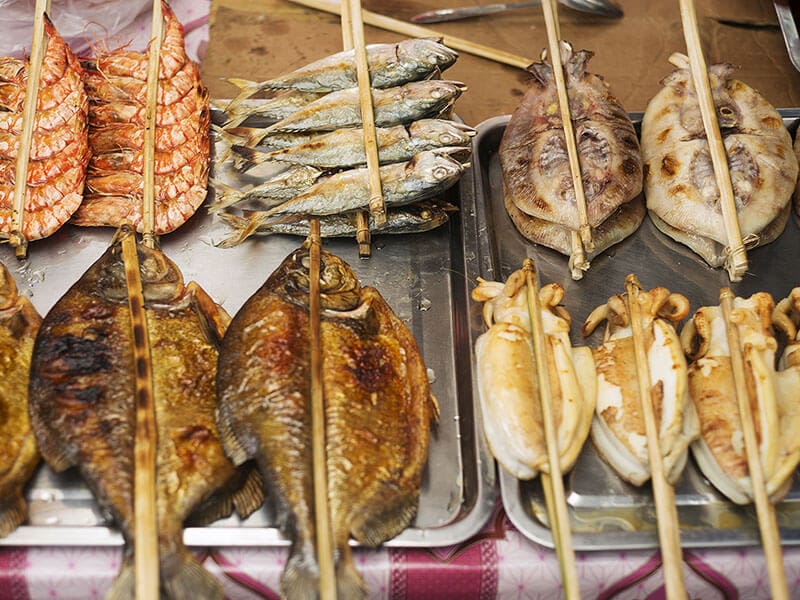
Cambodia is well-known for its abundant marine resources; thus, it is not unexpected that vendors sell grilled seafood. The majority of which are grilled squid and snails; besides, you can still see various other options, such as shrimp, fish, or shellfish.
Freshly caught seafood will be grilled on a charcoal grill until cooked, and when you bite into just one, you can feel the juice oozing out and spread evenly on your tongue.
Now, spread some scallions and oil on the food, then dip it into a chili sauce. The taste will surely be more intense and tempting. One note for you here is that Grilled Seafood is more frequently sold in the evening, so you’d better look for them at that time.
12. Che Kang
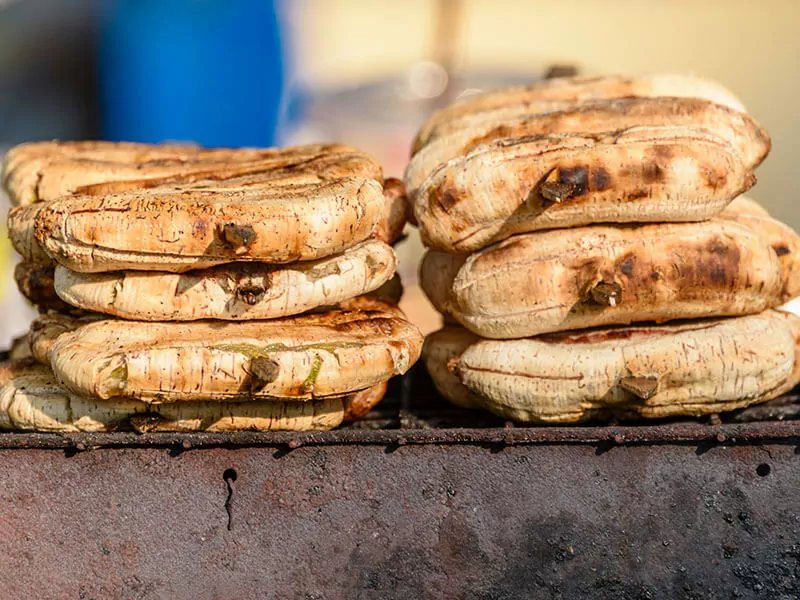
With Cambodia’s massive yearly banana production, this tasty fruit is made into various healthful and intriguing dishes, including this exotic Grilled Banana.
Regularly, the whole bananas are wrapped in sheets of fresh banana leaves grilled over a fiery charcoal fire. The finished Grilled Banana delivers the flavor of burnt banana leaves, a light smoky aroma that blends with the sweetness and aroma of bananas.
All create fantastic street food that makes many people flutter.
Is this Che Kang illustration enough to bring you to Cambodia?
13. Kangkeb Dot
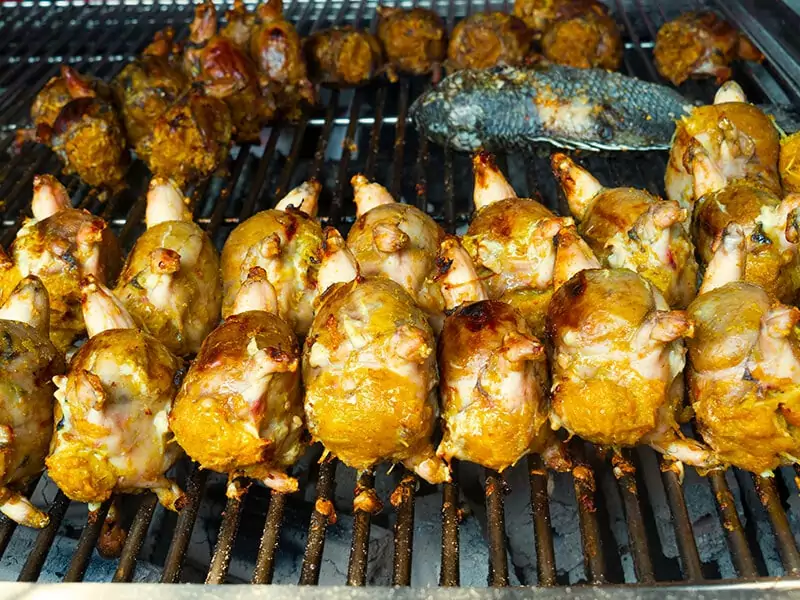
Before tasting this dish, I had heard a lot of reviews that frog meat tasted like chicken, and it was right. Although thinking of the image of a frog might take some people aback, its meat tastes terrific. You can feel lovely juiciness and tenderness from the first bite.
Cambodian people/sellers won’t usually sell only Grilled Frog; because of that, you should look for it at the Grilled Chicken stalls. My suggestion is to pluck up the courage to try it; the food will taste amazing after all.
14. Kwah Ko
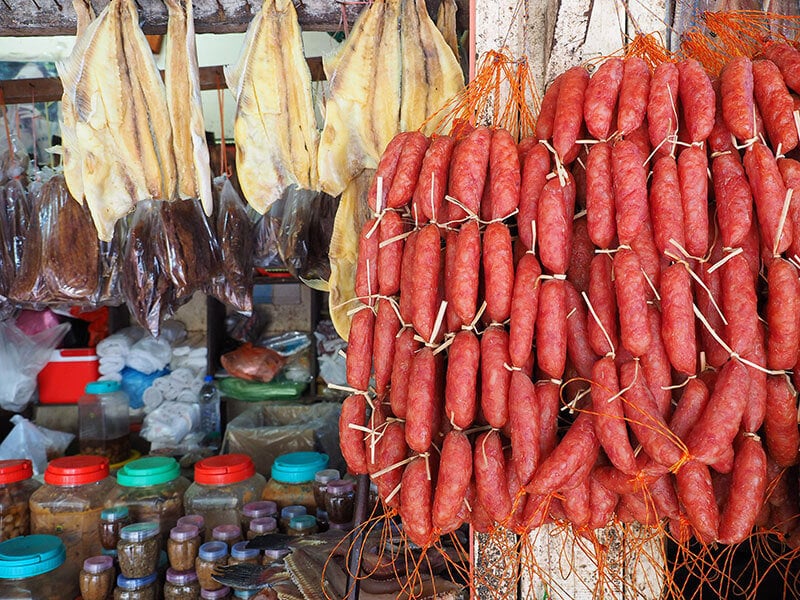
Made of half pork, half lard, and palm sugar, these unique red sausages will leave an unforgettable impression on you after the first bite. If you are more familiar with the meaty sausages, this Kwah Ko will taste somehow sweeter and fattier.
In Cambodia, or more specifically, on Phnom Penh streets, people will sell these Sweet Pork Sausages by skewing and grilling them, while other stalls will offer them sausage balls. Don’t forget a glass of cold beer when having Kwah Ho; that is how local people enjoy it.
15. Sankhya Lapov
(Pumpkin Pudding)
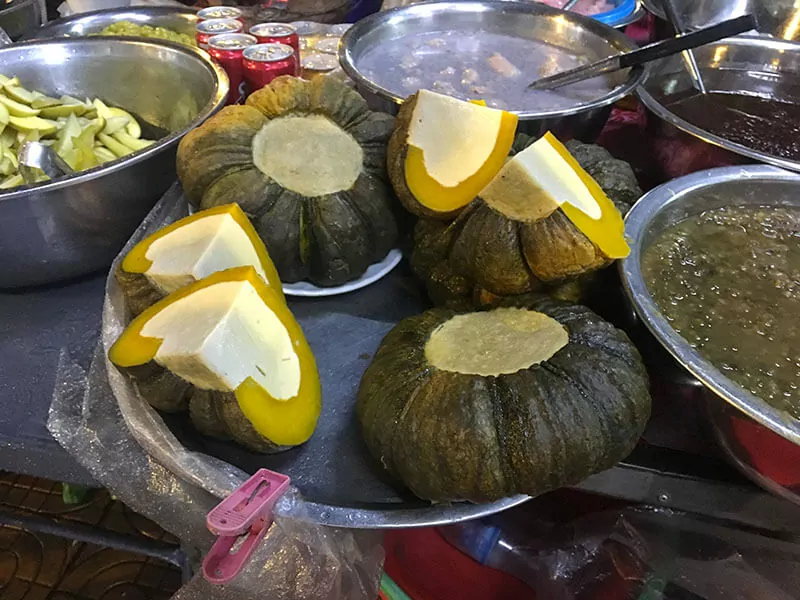
If you are a flan lover, you will absolutely love this Sankhya Lapov. It is a famous Cambodian dessert, which is also a notable food in Thailand and other Southeast Asia countries. People in this country will often prepare this luscious treat for festive occasions or religious festivals.
Pumpkin will be peeled on top and have all the seeds out. Then, layers of custard cream will be stuffed into the belly of the pumpkin and steamed. Enjoying this dish, you will feel the taste of pumpkin and rich cream.
Sankhya Lapov is truly a crowd pleaser; you can have it cold or warm since both ways will not affect your dish’s deliciousness.
16. Coconut Ice Cream
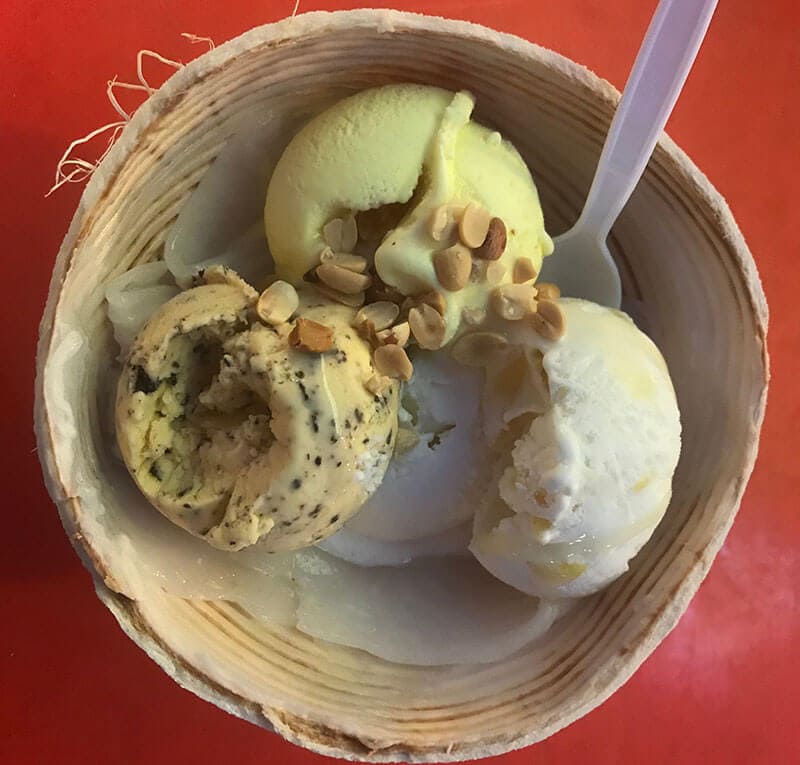
This fantastic dish will remind you of famous Thai desserts however, the taste and presentation are quite different. Here, Coconut Ice Cream is served in coconut shells, which offer an exciting feeling to the eaters.
At some ice cream stalls, they will serve chocolate cakes with coconut cream and add some crunchy roasted peanuts as a topping.
To create a complete version of Cambodian Coconut Ice Cream, you can use condensed coconut milk as a topping or simply sip some coconut water to enhance the flavor of this dish.
17. Chet Chien
(Deep Fried Bananas)

If you’re searching for a handy sweet dish to complete your Cambodian food tour, then the fried banana dish is a must-order. As mentioned, Cambodia produces a large number of bananas each year; therefore, people in this country have created many banana treats.
Making Chet Chien is straightforward; the bananas are pressed flat and then covered with a sweet batter and sesame seeds. After that, the cooks will deep fry the whole piece in hot oil until crispy.
You can either have it alone (with sprinkled sugar) to enjoy its crispy crust or have the treat with the previous Coconut Ice Cream for more flavors.
Chet Chien might look easy to make; yet, the Cambodian sellers need some real skills.
18. Cambodian Tapioca Pudding
Cambodian Tapioca Pudding is a decadent silky dish flavored with cinnamon, vanilla, coconut, and fresh fruits (such as banana). Smooth tapioca desserts meet creamy coconut, and the sweet-tart tastes of fresh fruits combine to form a pure, delightful pleasure!
This dish is quite versatile; you can consume it for breakfast or lunch, hot or cold, and have other fruit toppings (rather than only a banana). You should add Cambodian Tapioca Pudding to your foodie list and make sure to try it when coming to Cambodia.
19. Nom Lote
(Pandan Rice Pudding)
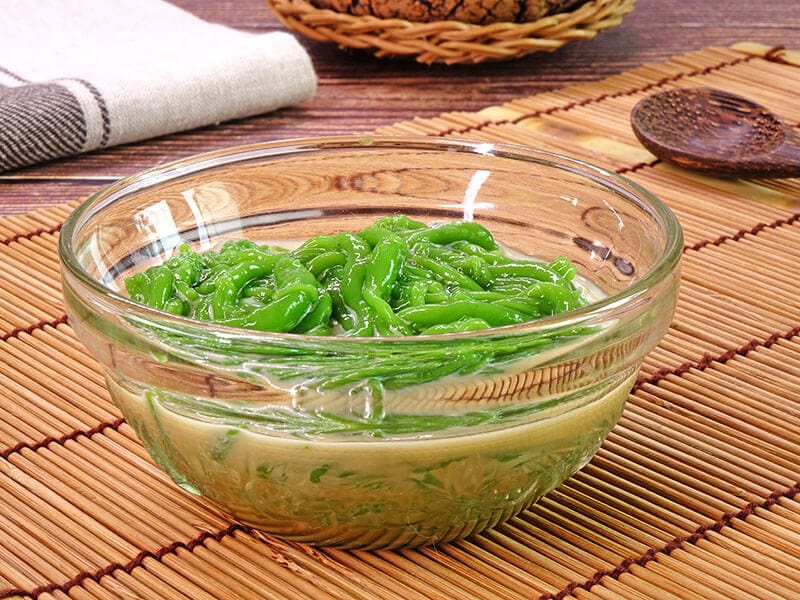
Pandan leaves are among the most used ingredients in Asian-style appetizers or typically in Southeast Asian desserts. Although the leaves have no taste, they are loved for their exotic creamy and sweet scent. Once you give this Nom Lote a go, you will understand why it is so popular.
To make a regular portion of Nom Lote, they will need to prepare rice flour, pandan leaf extract, white lime, coconut milk, and no dairy products included. Therefore, this Nom Lote is absolutely a vegan-friendly dessert, making it a perfect treat for more people.
20. Pickled Fruit
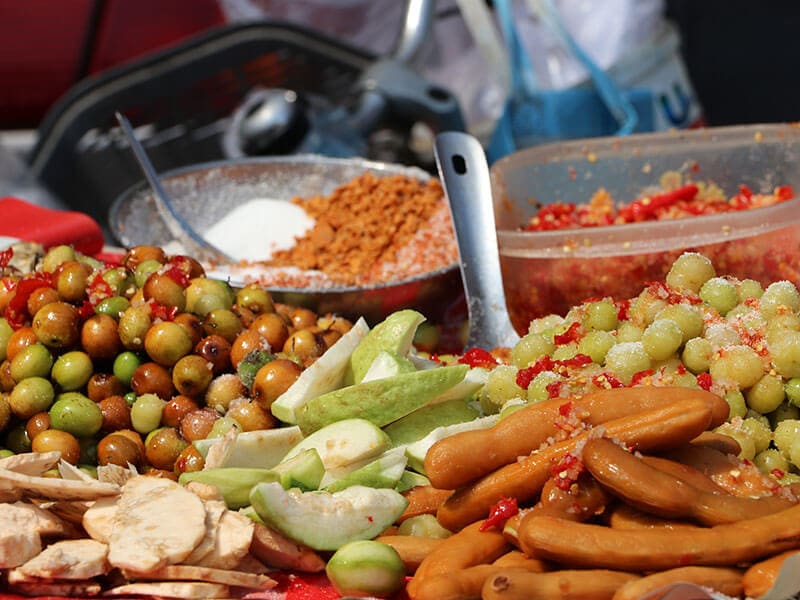
Are the colorful jars of pickled fruits, from mango, guava, apple, pineapple, to papaya, enough to tempt you? This is a trendy snack in Cambodia and is easy to find at sidewalk shops or markets.
It is no exaggeration to say that you can find any type of pickled fruit when coming to Cambodia.
Although these pickled fruits are quite spicy, thanks to the harmonious combination of other sweet and salty spices, this dish has become much more delicious. Once serving, the chef will give you a bit of dipping sauce to dip the fruit in.
21. Bey Dom Neib
(Mango Sticky Rice)
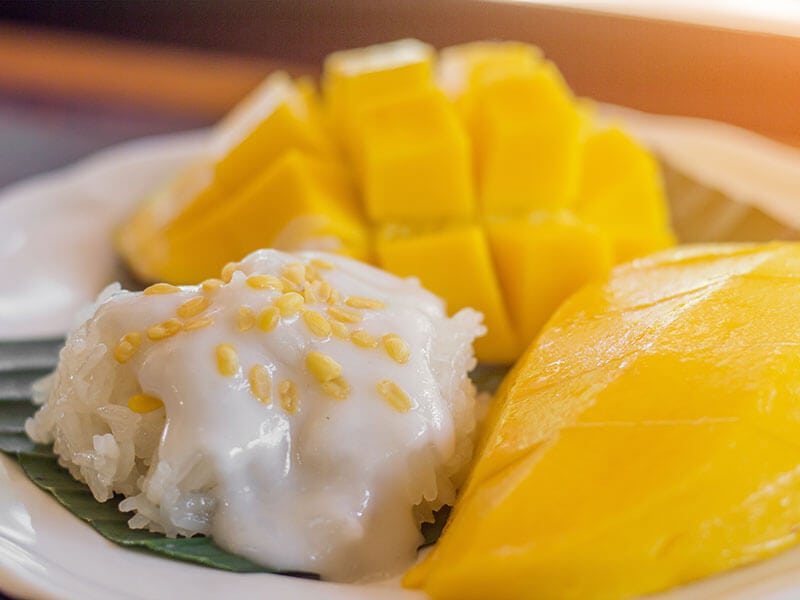
Mango sticky rice is a famous tropical dessert originating from Thailand. However, this dish is also extremely famous in other countries such as Cambodia, Vietnam, and Bangladesh.
The soft, white sticky rice full of richness from the coconut milk complements well with ripe yellow mango, which is sweet and refreshing, creating a famous dessert in various Khmer restaurants.
Just like that, these two excellent ingredients are combined to create an unforgettable dish in the heart of any diner.
The above dishes are not everything you can expect from street food in Cambodia; some other Cambodian must-have dishes await you in this next category. Scroll down now!
22. Balut (Fertilized Eggs)
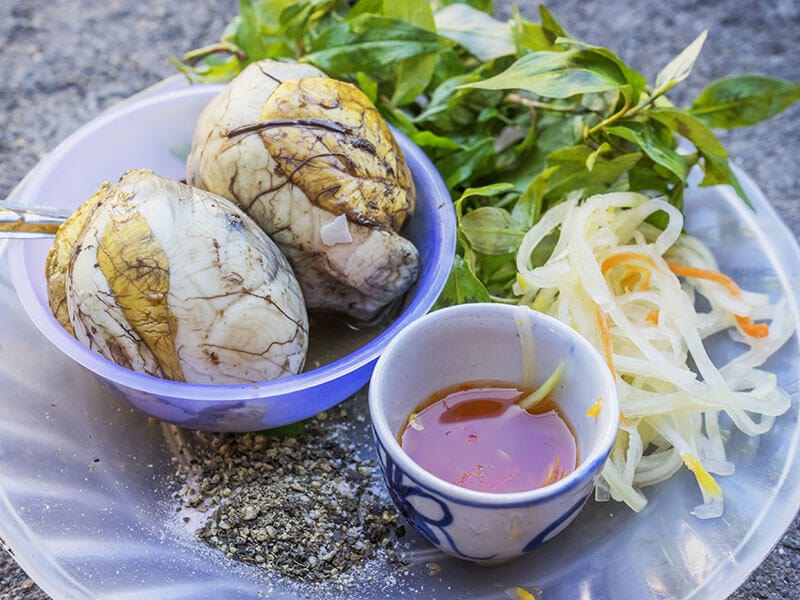
Balut is quite famous in Southeast Asian regions; you can also find it in the Filipino or Vietnamese recommended foods list. To make this food, duck or chicken eggs are fertilized, and the embryo is then left to develop until it reaches the ideal stage.
These eggs will be boiled before serving, and they are considered a good source of proteins. Balut is eaten uniquely in Cambodia; instead of cracking the egg and placing it in a little bowl, people eat it straight from the shell.
Add a small pinch of salt and pungent pepper with some lemon juice to taste, and your Balut is ready. Of course, this is not a good option for the fainthearted.
This funny taste challenge will tell you something about Balut’s flavors.
23. Kahve (Coffee)
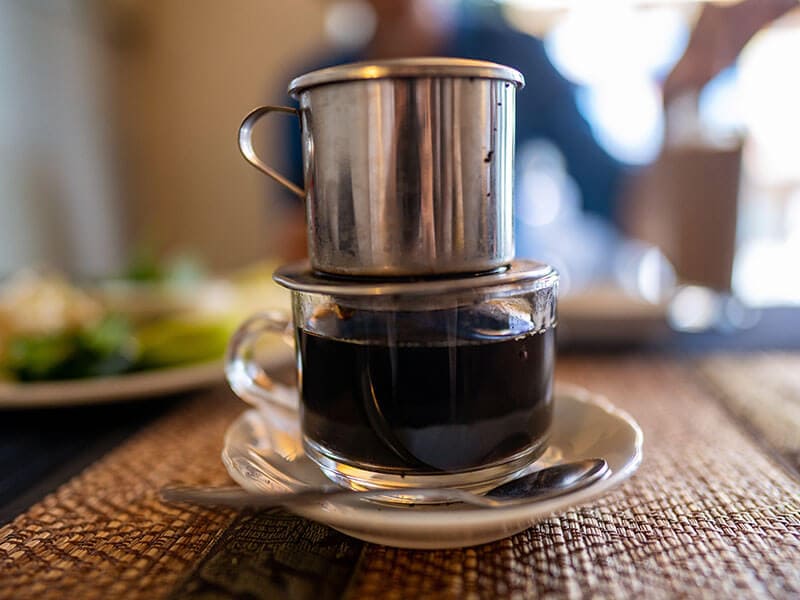
Sipping a delicious cup of coffee prepared by the people here to start a new day will undoubtedly be a fascinating experience for your trip. If you are a coffee fanatic, there is no reason to refuse this energy-booster drink.
Compared to the other variations of coffee globally, this lovely Cambodian-style drink tastes distinguished. You can have it as Black Coffee (without milk) or Milk Coffee, which will use condensed milk for a richer and sweeter taste. How versatile!
In particular, in Cambodia, there is a coffee museum called Golden Mountain Coffee Museum. Here, local people will detailedly introduce all information and images related to coffee in Cambodia.
When visiting this museum, you’ll learn the origin of Cambodian coffee, its production process, and many other exciting details. After all, you can obviously see how Cambodians love their favorable drink.
24. Chruok Svay
(Green Mango Salad)
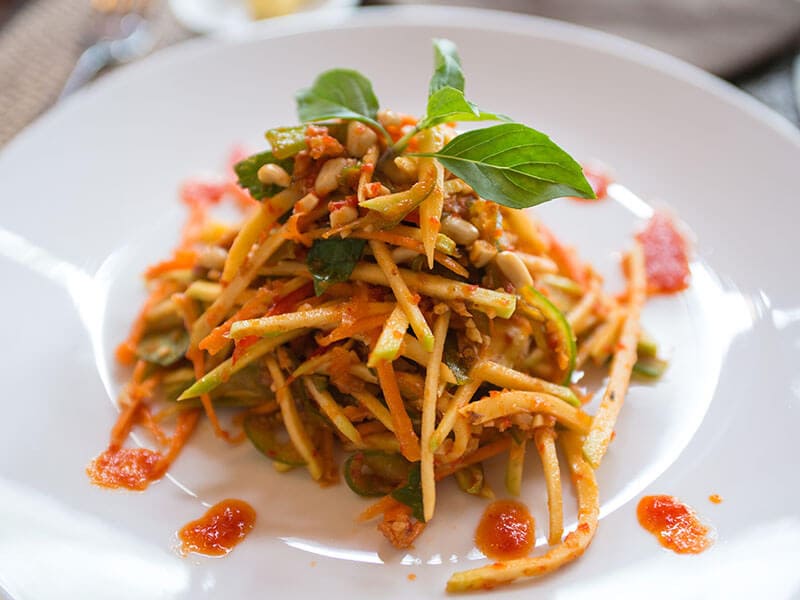
The Cambodian green mango salad has always been known for its pleasant feeling because it is mixed with many aromatic, intense, and alluring flavors.
Chruok Svay is very crispy and delicious; it consists of only fresh chili, kaffir lime juice, fish sauce, grated green mango, fresh herbs, and lean proteins (such as boiled shrimp, or roasted cashews). Because of that, this dish is considered a healthy food.
In Cambodia, people will have this dish alone as a light meal, appetizer, or a side dish besides hearty fish/meat stews or grills. Another variant of this exotic salad calls for fresh papaya and the same components. Trust me; you will want to try both of them.
25. Fried Bugs
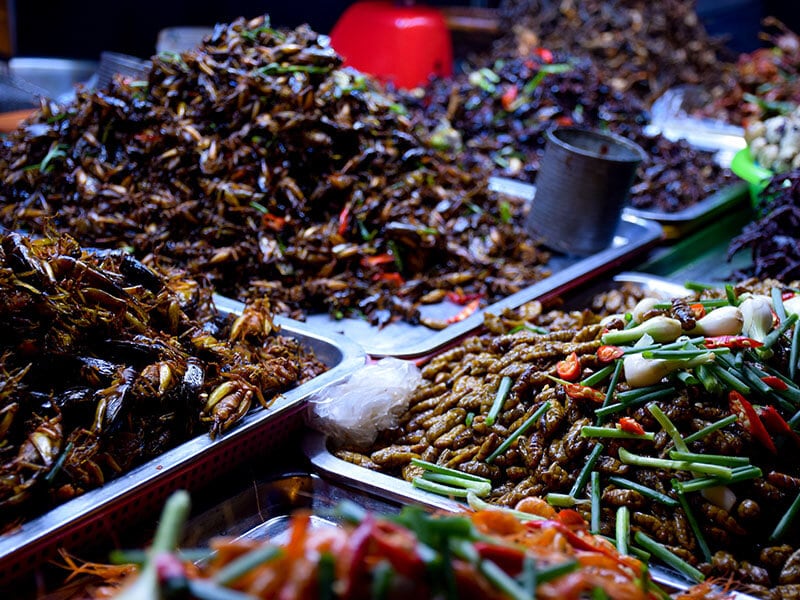
Cambodia has many dishes made from insects/bugs such as bugs and scorpions, just like Thailand’s famous street recipes. The insects/bugs are deep-fried, laid out on a tray, or skewered depending on the sellers.
The most popular kinds of insects used for this delicacy are crickets and silkworms. Other ingredients you can choose from are grasshoppers, cockroaches, ant eggs, spiders, beetles, and bamboo worms.
The story behind this treat is quite tragic. In the 1970s, people in this country experienced a terrible famine, and they had nothing else to eat but bugs and insects. These ingredients were loaded with nutrients that helped them go through the dark time.
26. Kam Pisa Chien
(Deep-Fried Shrimp or Prawn Cakes)
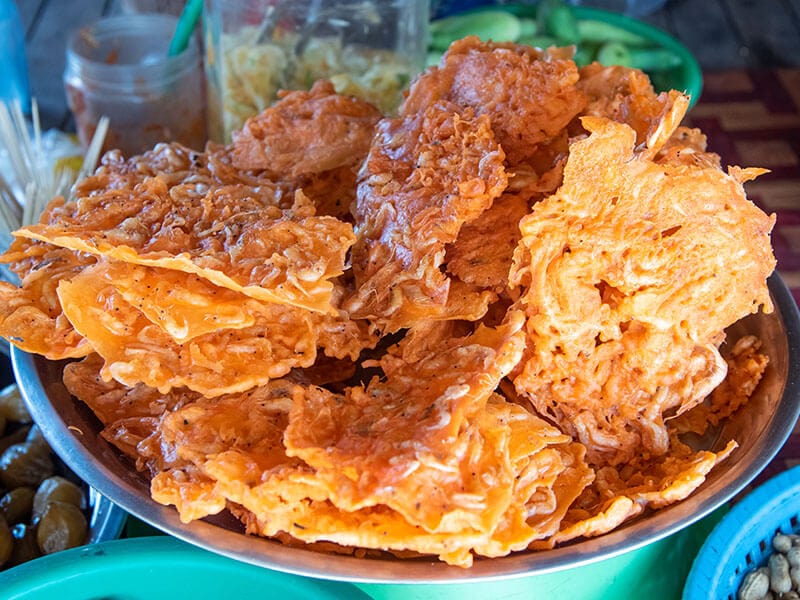
Kam Pisa Chien or Deep-Fried Shrimp Cakes is a famous street food in Cambodia, and it calls for French bread as the base. It is so appealing and scrumptious that you can easily see many street vendors selling this delicacy.
The shrimp/prawn’s shell won’t be removed before processing since it will help to enhance the crunchy effect when you have a bite. Since Kam Pisa Chien is quite oily, it is not healthy to consume frequently. Yet, it’s okay to have a piece from time to time.
27. Fish Amok
(Khmer Steamed Fish Curry)
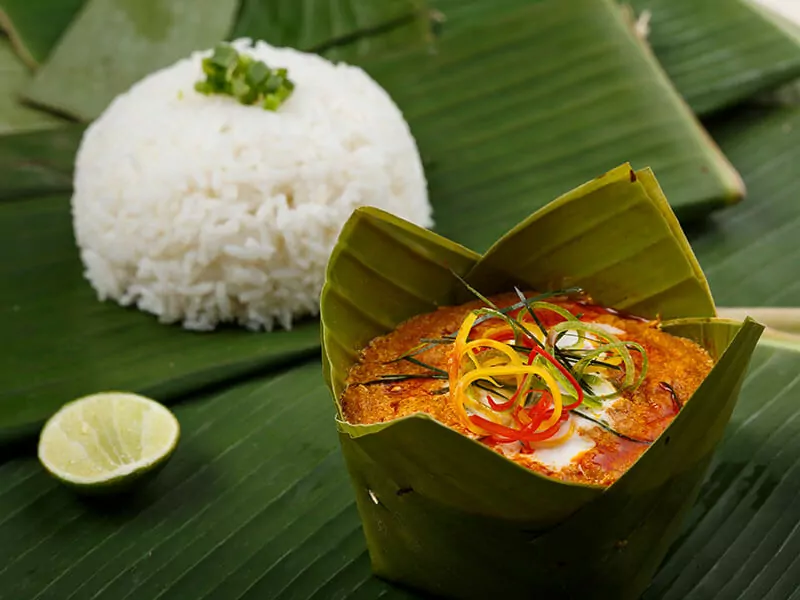
One of Cambodia’s unique and authentic dishes is Fish Amok, which has become an iconic delicacy for this country’s cuisine. People in Cambodia sell this treat often in night markets or on the street and serve it on lovely banana leaves.
Thanks to the unique combination of various ingredients (creating a unique taste), sweet jaggery, and rich coconut milk, this dish will surprise you with its taste.
The most frequently used fish in this Cambodian Fish Amok are goby fish, catfish, or snakehead fish. These fish are meaty and succulent, making the overall dish more delicious.
You might see several variations of Fish Amok in several countries around Cambodia, but you need to taste it once to know the difference between them.
Now, let a famous chef introduce to you Fish Amok!
28. Lok Lak
(Shaking Beef)
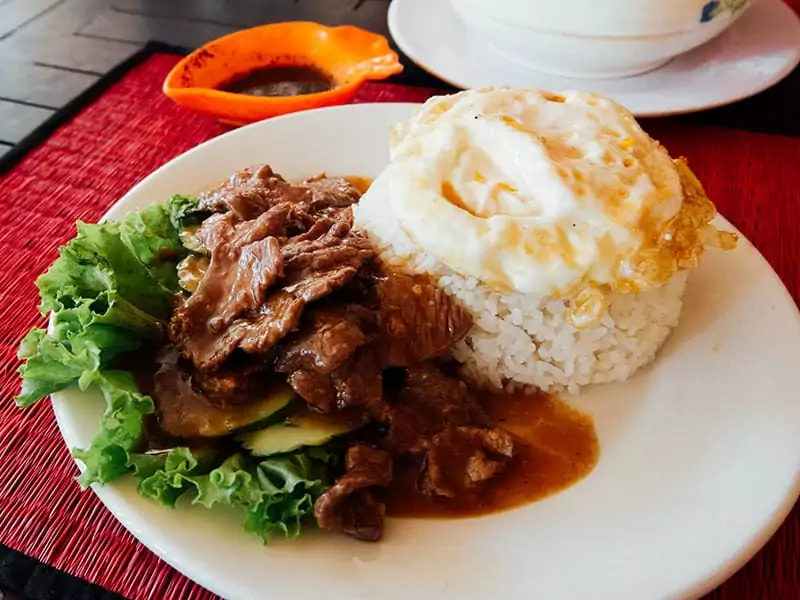
Lok Lak is not an authentic Cambodian recipe; it has its roots in Vietnamese Bo Luc Lac (Shaking Beef). The Cambodian-style Lok Lak calls for special local meat called juicy beef. Many people in this gorgeous country love that type of meat.
In general, to process this food, the sellers will stir-fry their well-marinated meat and serve it with fresh veggies (green salad, tomatoes, cucumber) or pungent herbs/condiments. Every component will complement each other well, and a scrumptious beef-y dish is created.
It Is Time To Try Some Street Food In Cambodia!
If you enjoy traveling and discovering new places, you would agree that eating street foods is the easiest and most effective approach to learning about native customs.
It can be claimed that street food in every country has its own intriguing and unique aspects; Cambodian street food is no exception. I hope that my suggestions today can assist you well on the journey of learning/discovering more about Cambodian cuisine.
Have you had any experience tasting my recommendation? Feel free to leave a comment and tell me your feelings about them. Your contribution is a great motivation for me.
